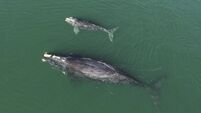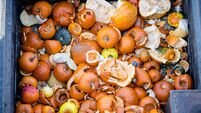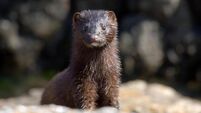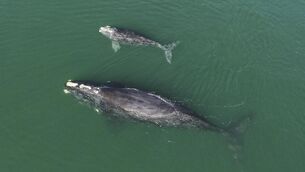Mysterious mushrooms — the largest living organism on our planet
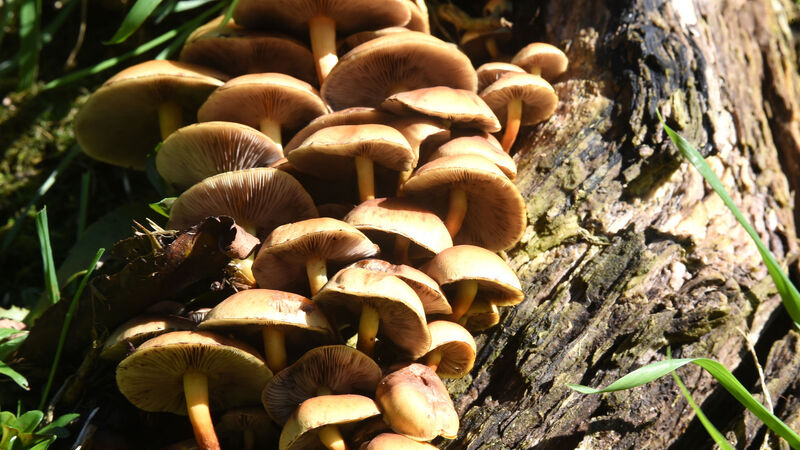
Mushrooms growing on a decaying tree stump, in bright winter sunshine. Picture: Larry Cummins
Mushrooms are mysterious. Here in Ireland, we tend to treat wild mushrooms with suspicion, terrified at the possibility of poisoning. Across Scandinavia and continental Europe, however, people are brought up to enjoy, recognise, and celebrate the arrival of mushroom season. And now, during September and October, families are eagerly venturing out on foraging excursions. We Irish, by contrast, are relatively impoverished of traditions around collecting and eating wild mushrooms.
It's not especially difficult to learn to reliably identify a handful of edible mushrooms. There are about 20 species here that are both common and worth eating, and were once widely harvested. Field mushrooms are widely recognised and just about the only mushroom that Irish people will readily gather up and cook. Bright yellow chantarelles, with their faint fragrance of apricots, are another of the best edible mushrooms.

But in total, there are an estimated 7,000 species of mushroom-producing fungi that grow in Ireland. Only about 5% of these are edible, which adds up to a lot more than just 20 species, though many of these aren’t much worth eating, being too chewy, difficult to prepare, or just not especially tasty. Mushrooms have been harvested here as food and medicine since ancient times, though it takes skill to learn about harvesting, and preparation of both medicinal and nutritional fungi.
Many mushrooms are toxic and can cause significant harm — especially liver and kidney problems — if eaten. To stay safe, follow the basic rule of never eating a fungus that you cannot positively identify without any doubt as being an edible species. If in doubt, any doubt at all, leave it out. Even at that, I’ve had a sore tummy from eating a generous helping of ‘Chicken of the woods’ foraged from the wild. Widely regarded as being delicious, it can be hard to digest for some, as I learned.

But let’s start by taking a look at what exactly mushrooms are. When we bend to examine or perhaps pick a mushroom, we are looking at one part of a much larger organism. The toadstools we see growing from the ground; the little clusters of mushrooms that we admire growing from fallen tree limbs; or the field mushrooms dotting the old paddock, these are just one small part of a much larger organism.

The bulk of the body of the fungus comprises a mass of fine threads called hyphae. These microscopic filaments grow underground, or inside the rotting log, or through the leaf litter, depending on the preferred substrate for that particular species. These fungi can be enormous, their hyphae spreading across many kilometres underground, weaving through the soil for hundreds and even thousands of years. This is how fungi are now known to be the largest living organism on our planet. Only in recent years are researchers calculating that fungi comprise a quarter of the world’s biomass, long overlooked because they are mostly underground or otherwise unseen.

The mushrooms we know and see as somewhat familiar things, the parts that emerge above the ground, these are the fruiting bodies of fungi, there to produce and disperse spores at certain times of year. In the same way that plants produce many more seeds than will necessarily germinate, a strategy to increase the odds of reproductive success, mushrooms produce enormous quantities of spores. A field mushroom, just a few cm tall, releases about 100 million spores per hour through its gills. A giant puffball produces about seven billion spores.

The kingdom of fungi includes yeasts, such as the yeast that make the bread we eat as well as for brewing beer and wine. But yeasts are even more common than this: yeasts live on our skin, in our lungs, and in our intestine. The fungi kingdom, specifically yeasts, are literally part of who we are. Like everything in nature, we are not individuals at all, but a product of symbiosis between many kinds of organisms, dependant on a plethora of both internal and external partnerships.
Fungi make life for all of us possible. They have almost infinite variety of functions in the world: breaking down dead wood; recycling nutrients that maintain all fertile soils; and assisting plants to draw nutrients from their surrounds. Almost all plants, including trees, have mycorrhizal relationships with fungi in the soil which enable them to thrive, making the plant kingdom dependent on the kingdom of fungi, in the same way that the animal kingdom is dependent on the plant kingdom. None of us would be here without fungi.

A great way to gain familiarity with the world of fungi is to go on a guided mushroom foraging trip. Ideally, find a guide who is professionally accredited, such a member of the Association of Foragers (a UK/European wide professional foragers group). They will help you learn about foraging and teach you to identify edible, toxic, or deadly fungi. Good guidebooks are useful too, though as a beginner, nothing compares to in-person guidance.
Patatas bravas and baked mushrooms
Many more mushroom recipes here
For those with a fondness of foraging, it soon becomes clear that the appeal is so much more than the satisfaction of bringing home a bounty of edible things. The real pleasure is the experience of being in the outdoors, immersed in hours of purposeful rambles, noticing things you’d never otherwise notice. It’s about being curious and observant. Foraging endows a meditative calm that is good for body and mind. Having a basket full of choice culinary mushrooms to eat is a bonus.

Fungi are complex, intriguing, daunting, and beautiful. Learning the skills of mushroom foraging can bring years of joy, in both the act of finding and foraging as well as learning to cook and eat a few favourite species. And for many, it will open up a new appreciation for these endlessly surprising organisms.



